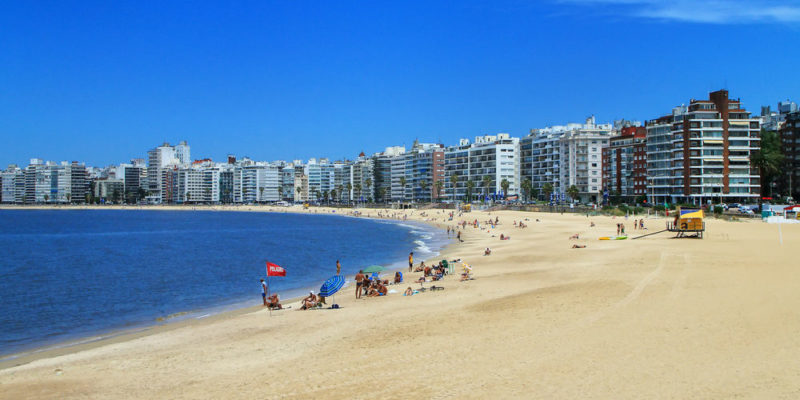We explain everything about Uruguay, where it is located and what its climate and population are like. Also, what are its features, economy and more.
What is Uruguay?
Officially called the Oriental Republic of Uruguay, this South American nation in the southern region of the subcontinent is a sovereign state under a presidential and democratic regime, famous for its small size and small population , which allow it standards of living that are much more controlled than those of its neighbors. more voluminous.
Founding country of international institutions such as the UN, OAS, UNASUR and others , it is one of the most equitable in the distribution of wealth in the entire continent (along with Costa Rica), the one with the highest literacy rate and the lowest rate. perception of corruption, and one of the three with the highest human development index in the entire region.
Many publications rank it among the safest, greenest, and most democratic countries in the world , as well as the most peaceful on the continent, which is why it is often referred to as the “Switzerland of America,” to refer to its neutrality in regional conflicts.
However, it is known of the sustained economic crisis that the nation went through during the entrance of the 21st century, as well as the military dictatorship that ruled the country between 1973 and 1985.
Name Uruguay
During colonial times this territory was known as the Banda Oriental, then the Eastern Province, the Cisplatina Province during the Portuguese-Brazilian invasion (1816-1828) and, finally, when it was declared an independent territory, such as Uruguay, a name inherited from its most important river. and word of Guarani origin . Some interpretations translate it as "Rio de Urú", "River of the snails" or "River of the birds", but there is no consensus in this regard.
Location and limits of Uruguay

Uruguay is located in the so-called southern cone of South America , in its eastern region, and its territory is bordered to the north by Brazil , to the west by Argentina , to the south by the Río de la Plata and to the east by the Atlantic Ocean .
Surface and territorial extension of Uruguay
Uruguay is the second smallest country in terms of size in South America , after Suriname. Its total area is 176,215 km2, of which 660 km are coastline and 1,591 km borders with neighboring countries.
Most of the territory is a vast undulating plain , furrowed by small hills called blades and its highest point is Cerro Catedral at 514 meters above sea level.
Capital of Uruguay

The capital of Uruguay is also its most populated city: Montevideo, headquarters of Mercosur and ALADI . It is the southernmost capital of America , located in the southern region of the Uruguayan territory, on the coasts of the Río de la Plata.
Founded around 1726 , it is the main port in the region, in the river's homonymous bay, and it is the seventh Latin American city and the eighth most visited by tourists in Latin America in 2013.
Uruguay Climate
In Uruguay, the climate varies little between humid temperate and humid subtropical , whose changes are due to the winds and the seasons of the year.
The average temperature is 17 ° C with hot summers and regular precipitation more or less all year round , with maximum peaks in spring and autumn. The northern region of the country is considerably warmer and rainier, and the southern region is colder and drier.
Uruguayan population

The total population of Uruguay is barely 3.29 million inhabitants , according to 2011 data, which places it in tenth place on the continent. 88% of its population is of Spanish descent and more than a quarter of Italian descent. The mestizo population is barely 8% and the African descendant barely 4%. The indigenous population is almost non-existent.
Uruguay has traditionally been a nation of emigrants , although it also received waves from Europe during the 20th century , in its greatest period of stability.
Most of the Uruguayan expatriates reside in Argentina, Spain , Italy , the United States, Brazil and Canada, mainly.
The predominant language in the population is Spanish and the religion is Catholic. However, there are dialect variants of Portuguese known as “portuñol riverense”, frequent on the border with Brazil.
Uruguay currency
The local currency since 1993 is the Uruguayan peso, represented with $ or the ISO code UYU , which replaced the new peso N $, the currency that had been in force since 1975, in turn, replacing the old Uruguayan peso. This conversion took place in terms of N $ 1000 per $ U1.
History of Uruguay

The founding of the country as an independent entity did not occur until 1830, since in colonial times it was part of the Viceroyalty of Río de la Plata , based in Buenos Aires , just like the Government of Montevideo. In 1816 it fell under the power of the United Kingdom of Portugal, Brazil and the Algarve, giving rise to the Cisplatina Province.
Finally, in 1825 there was an emancipatory feat called the Eastern Thirty-three , continued with the Brazilian War, the conclusion of which in 1828 laid the foundations for the constitution of the Eastern State of Uruguay.
From then on, a period of persecution of the original Charrúa settlers and internal political instability began, which between divisions and revolutions led the country to the War of the Triple Alliance against Paraguay . Its civil wars would continue until the beginning of the 20th century, when Uruguay's export engine led to economic stability.
This period came to an end around the 1950s and 1960s , when an economic crisis and social and economic deterioration led to the agitation of the left-wing union sectors and the beginning of the urban guerrilla known as “Tupamaros”.
The response that came from the extreme right was translated into radical groups and the subsequent establishment of a civic-military dictatorship established by Juan María Bordaerry in 1973.
Uruguay regained democracy in 1985 after years of cruel repression and forced disappearances. His republican path faced a new economic, political and social crisis much later in 2002, a period from which they will emerge under the mandate of the democratic left of Tabaré Vásquez (2005-2010), José Mujica (2010-2015) and again Vásquez ( 2015-2020).
National symbols of Uruguay

The national symbols of Uruguay are three:
- The national flag. Composed of the colors white and blue in horizontal stripes, along with a golden sun with a face in an upper box next to the flagpole.
- The National emblem. Decreed in 1908, it consists of an oval crowned by a sun and divided into four quarters, each one with, respectively: a yellow scale on blue enamel in the upper left, the Cerro de Montevideo in the upper right, a loose horse in the lower left and a yellow ox on blue enamel in the lower right. The oval bordered by olive and laurel branches, joined by a sky blue bow.
- The National anthem. Whose lyrics are authored by Francisco Acuña de Figueroa and music by Francisco José Debali, it was composed in 1833, revised in 1845 and definitively set to music in 1848.
Uruguay Economy

Uruguay's main economic activities are agriculture and livestock, along with tourism , since mineral resources are scarce. The main industries in the country are paper , cardboard, cement, and oil refining. The cities of Montevideo, Punta del Este, Colonia del Sacramento, Salto, Lavalleja and Rocha represent important tourist bastions, especially during carnival times.
The above content published at Collaborative Research Group is for informational and educational purposes only and has been developed by referring reliable sources and recommendations from technology experts. We do not have any contact with official entities nor do we intend to replace the information that they emit.
Luke is passionate about fostering student involvement and connection. He studied psychology for his major and likes learning about the past. Luke aims to specialize in artificial intelligence and cybersecurity. .
Leave a reply
Your email address will not be published. Required fields are marked *Recent post

Sport: What Is It, Types, Risks, Features, Characteristics and Examples

Dogs: Emergence, Features, Characteristics, Feeding and Breeds

Story: Definition, Elements, Structure, Features and Characteristics

